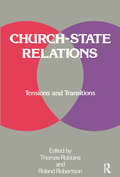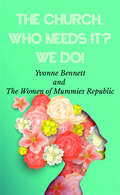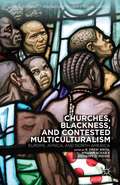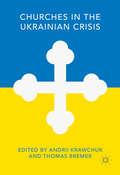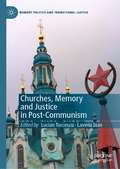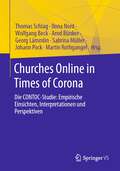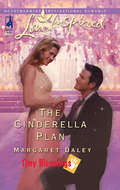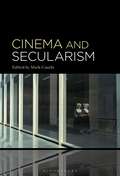- Table View
- List View
Church-state Relations: Tensions and Transitions
by Thomas RobbinsEncounters between agents of the state and religious organizations have been increasing throughout the world, thus the need to understand the relationships between religion and other major domains of life is increasingly important. In this comprehensive reader on church-state relations, scholars examine the connections between religion and political life from a comparative perspective.
Church-state Relations: Tensions and Transitions
by THOMAS ROBBINS; ROLAND ROBERTSONEncounters between agents of the state and religious organizations have been increasing throughout the world, thus the need to understand the relationships between religion and other major domains of life is increasingly important. In this comprehensive reader on church-state relations, scholars examine the connections between religion and political life from a comparative perspective.
Church-State Relations in Africa in the Nineteenth and Twentieth Centuries: Mission, Empire, and the Holy See (Cambridge Imperial and Post-Colonial Studies)
by Jairzinho Lopes PereiraThis edited collection examines church-state relations in the European colonies in Africa during the late nineteenth and twentieth centuries. The chapters focus on the period stretching from the most agitated stages of the ‘scramble for Africa’ during the 1870s and 1880s, to the great wave of independence of African colonies in the 1950s and 60s, and culminates in a discussion of colonial legacies during its aftermath. The Church and the State, although often having conflicting goals and agendas, walked hand-in-hand throughout the entire colonial period, with ‘imperialism of the spirit’ being inconceivable without the groundwork of Catholic missionaries. Exploring the major domains that determined the course of church-state relations in the colonies, the authors analyse relations between the Holy See and the colonial powers, and between national Catholic authorities and secular authorities, as well as the international order and socio-political developments in the metropoles. They argue that interactions between state and church in Africa’s European colonies were contingent upon the complex dynamics of interests that both secular and ecclesiastical entities endeavoured to preserve or promote. With a particular focus on the Belgian and Portuguese colonies in Africa, this book provides useful reading for scholars of European imperial history and ecclesiastical history.
Church Transfusion: Changing Your Church Organically--From the Inside Out (Jossey-Bass Leadership Network Series #63)
by Neil Cole Phil HelferJust as our life is in our blood, the life for Christ’s body is in His blood. Changing a church is more than a new goal or direction. Our churches need more than an organizational transition; we need a full transfusion of Jesus' blood, His life, within every disciple. Anything less than that will only perpetuate more of the dysfunction and unhealthy church practices that have already plagued us for too long. We are in desperate need of the internally transforming power of the gospel of grace and the presence of Christ so that our salvation is then worked out in a way the rest of the world will notice. It isn’t enough that we believe in the facts contained in the gospel, we must allow the gospel itself to infect our souls and transform us from within. The DNA of Jesus' lifeblood is needed in our churches and nothing shy of a full transfusion that touches every cell will be sufficient. In this book Neil Cole (author of Organic Church, Church Transfusion and Journeys to Significance) and Phil Helfer, co-founders of Church Multiplication Associates, will first point out that change is possible with God, but only with God. In the second half of the book they will lay out some of the actual practical considerations to weigh if you want to release real organic health in your church. Using multiple examples of very different kinds of churches that have been through the process, the authors present ways that leadership and practices need to change in order to release organic church movements from their midst. Chapters cover: Leadershifts necessary Detoxification from dependence issues. How to ignite change virally. How to grandparent movements. How to measure success in movements. This book (another in the Leadership Network series) applies organic life principles to established churches with practical help that is holistic and natural. The content in this book will be helpful whether you are pastor of an established church or wanting to revitalize a small organic church. Jesus didn’t die and rise from the dead so that we can be like everyone else in the world. Our faith is more than just a better doctrine or a bigger goal with a capital giving campaign; it is a better life. Jesus is the difference, and what a difference he makes...don't be satisfied with less.
Church Transfusion: Changing Your Church Organically--From the Inside Out (Jossey-Bass Leadership Network Series #63)
by Neil Cole Phil HelferJust as our life is in our blood, the life for Christ’s body is in His blood. Changing a church is more than a new goal or direction. Our churches need more than an organizational transition; we need a full transfusion of Jesus' blood, His life, within every disciple. Anything less than that will only perpetuate more of the dysfunction and unhealthy church practices that have already plagued us for too long. We are in desperate need of the internally transforming power of the gospel of grace and the presence of Christ so that our salvation is then worked out in a way the rest of the world will notice. It isn’t enough that we believe in the facts contained in the gospel, we must allow the gospel itself to infect our souls and transform us from within. The DNA of Jesus' lifeblood is needed in our churches and nothing shy of a full transfusion that touches every cell will be sufficient. In this book Neil Cole (author of Organic Church, Church Transfusion and Journeys to Significance) and Phil Helfer, co-founders of Church Multiplication Associates, will first point out that change is possible with God, but only with God. In the second half of the book they will lay out some of the actual practical considerations to weigh if you want to release real organic health in your church. Using multiple examples of very different kinds of churches that have been through the process, the authors present ways that leadership and practices need to change in order to release organic church movements from their midst. Chapters cover: Leadershifts necessary Detoxification from dependence issues. How to ignite change virally. How to grandparent movements. How to measure success in movements. This book (another in the Leadership Network series) applies organic life principles to established churches with practical help that is holistic and natural. The content in this book will be helpful whether you are pastor of an established church or wanting to revitalize a small organic church. Jesus didn’t die and rise from the dead so that we can be like everyone else in the world. Our faith is more than just a better doctrine or a bigger goal with a capital giving campaign; it is a better life. Jesus is the difference, and what a difference he makes...don't be satisfied with less.
Church Turned Inside Out: A Guide for Designers, Refiners, and Re-Aligners (Jossey-Bass Leadership Network Series #34)
by Linda Bergquist Allan KarrA design-thinking book for planting or redesigning churches and incubating a new generation of leaders. Written by Linda Bergquist and Allan Karr, two experienced church planters and mentors, the book is full of wisdom, practical advice, and creative counsel. Instead of a business-model-as-usual approach, the authors challenge readers to begin with the raw materials of beliefs, values, individuals, teams, and culture, and to then move outwards to draw from a rich palette of real and potential church paradigms. This book is meant to provoke church leaders to think outside of the box and to imagine how their churches might better reflect the image and the mission of God in the world. Contains a wealth of illustrative examples, charts, and other visual aides Offers a creative practical perspective and a multi-disciplinary approach to establishing a new church or leading an existing one Shows how to honor a church's purpose while embracing its unique culture Includes important lessons for nurturing church leadership skills
Church Turned Inside Out: A Guide for Designers, Refiners, and Re-Aligners (Jossey-Bass Leadership Network Series #34)
by Linda Bergquist Allan KarrA design-thinking book for planting or redesigning churches and incubating a new generation of leaders. Written by Linda Bergquist and Allan Karr, two experienced church planters and mentors, the book is full of wisdom, practical advice, and creative counsel. Instead of a business-model-as-usual approach, the authors challenge readers to begin with the raw materials of beliefs, values, individuals, teams, and culture, and to then move outwards to draw from a rich palette of real and potential church paradigms. This book is meant to provoke church leaders to think outside of the box and to imagine how their churches might better reflect the image and the mission of God in the world. Contains a wealth of illustrative examples, charts, and other visual aides Offers a creative practical perspective and a multi-disciplinary approach to establishing a new church or leading an existing one Shows how to honor a church's purpose while embracing its unique culture Includes important lessons for nurturing church leadership skills
Church Unique: How Missional Leaders Cast Vision, Capture Culture, and Create Movement (Jossey-Bass Leadership Network Series #38)
by Will ManciniWritten by church consultant Will Mancini expert on a new kind of visioning process to help churches develop a stunningly unique model of ministry that leads to redemptive movement. He guides churches away from an internal focus to emphasize participation in their community and surrounding culture. In this important book, Mancini offers an approach for rethinking what it means to lead with clarity as a visionary. Mancini explains that each church has a culture that reflects its particular values, thoughts, attitudes, and actions and shows how church leaders can unlock their church's individual DNA and unleash their congregation's one-of-a-kind potential.
Church Unique: How Missional Leaders Cast Vision, Capture Culture, and Create Movement (Jossey-Bass Leadership Network Series #23)
by Will ManciniWritten by church consultant Will Mancini expert on a new kind of visioning process to help churches develop a stunningly unique model of ministry that leads to redemptive movement. He guides churches away from an internal focus to emphasize participation in their community and surrounding culture. In this important book, Mancini offers an approach for rethinking what it means to lead with clarity as a visionary. Mancini explains that each church has a culture that reflects its particular values, thoughts, attitudes, and actions and shows how church leaders can unlock their church's individual DNA and unleash their congregation's one-of-a-kind potential.
The Church Who Needs It? We Do!
by Yvonne BennettA group of mums in South London living in poverty come together to form a group to help each other. They talk of their struggles on Universal credit and the ways in which a pioneer Methodist missionary has brought them together. Not all have a faith, but all believe in the power of prayer. Their struggles escalate as the pandemic lockdown comes into play. They start a blog and use this to express their feelings. This book is their voice.
Churches and Churchyards (Shire Library)
by Richard HaymanThe parish church is a symbol of continuity, a cornerstone of the urban and rural landscape, and a treasure trove often as rich in cultural history as any museum. This compact and accessible guide explores all of these aspects of the parish church. It begins by examining why churches are built where they are, and then goes on to explain how both church buildings and churchyards have changed over time. It also describes the fixtures and furnishings in the parish church, including fonts, screens, stained glass and monuments, explaining their ritual and symbolic purpose and how their significance has shifted over time. Lavishly illustrated with colour photographs, this book will provide an indispensable introductory guide to anyone who is curious about the nation's parish churches and wants to explore them further.
Churches and Churchyards (Shire Library)
by Richard HaymanThe parish church is a symbol of continuity, a cornerstone of the urban and rural landscape, and a treasure trove often as rich in cultural history as any museum. This compact and accessible guide explores all of these aspects of the parish church. It begins by examining why churches are built where they are, and then goes on to explain how both church buildings and churchyards have changed over time. It also describes the fixtures and furnishings in the parish church, including fonts, screens, stained glass and monuments, explaining their ritual and symbolic purpose and how their significance has shifted over time. Lavishly illustrated with colour photographs, this book will provide an indispensable introductory guide to anyone who is curious about the nation's parish churches and wants to explore them further.
Churches, Blackness, and Contested Multiculturalism: Europe, Africa, and North America (Black Religion/Womanist Thought/Social Justice)
by R. Drew Smith William Ackah Anthony G. ReddieThis volume assesses contemporary church responses to multicultural diversity and resisted categories of social difference, with a central focus on whether or how racial, ethnic, religious, sexual, and gender differences are validated by churches (and especially black churches) torn between competing inclusive and exclusive tendencies.
Churches in the Ukrainian Crisis
by Andrii Krawchuk and Thomas BremerThis volume explores the churches of Ukraine and their involvement in the recent movement for social justice and dignity within the country. In November of 2013, citizens of Ukraine gathered on Kyiv's central square (Maidan) to protest against a government that had reneged on its promise to sign a trade agreement with Europe. The Euromaidan protest included members of various Christian churches in Ukraine, who stood together and demanded government accountability and closer ties with Europe. In response, state forces massacred over one hundred unarmed civilians. The atrocity precipitated a rapid sequence of events: the president fled the country, a provisional government was put in place, and Russia annexed Crimea and intervened militarily in eastern Ukraine. An examination of Ukrainian churches’ involvement in this protest and the fall-out that it inspired opens up other questions and discussions about the churches’ identity and role in the country’s culture and its social and political history. Volume contributors examine Ukrainian churches’ historical development and singularity; their quest for autonomy; their active involvement in identity formation; their interpretations of the war and its causes; and the paths they have charted toward peace and unity.
Churches, Memory and Justice in Post-Communism (Memory Politics and Transitional Justice)
by Lucian Turcescu Lavinia StanThis book is the first to systematically examine the connection between religion and transitional justice in post-communism. There are four main goals motivating this book: 1) to explain how civil society (groups such as religious denominations) contribute to transitional justice efforts to address and redress past dictatorial repression; 2) to ascertain the impact of state-led reckoning programs on religious communities and their members; 3) to renew the focus on the factors that determine the adoption (or rejection) of efforts to reckon with past human rights abuses in post-communism; and 4) to examine the limitations of enacting specific transitional justice methods, programs and practices in post-communist Central and Eastern Europe and the Former Soviet Union countries, whose democratization has differed in terms of its nature and pace. Various churches and their relationship with the communist states are covered in the following countries: Germany, Poland, the Czech Republic, Slovakia, Romania, Albania, Bulgaria, Estonia, Latvia, Lithuania, Russia and Belarus.
The Churches of Christ (Denominations in America)
by Richard T. HughesThis volume tells the story of the Churches of Christ, one of three major denominations that emerged in the United States from a religious movement led by Alexander Campbell and Barton W. Stone in the early 19th century. Beginning as an effort to provide a basis on which all Christians in America could unite, the leaders of the movement relied on the faith and practice of the primitive church. Ironically, this unity movement eventually divided precisely along the lines of its original agenda, as the Churches of Christ rallied around the restorationist banner while the Disciples of Christ gathered around the ecumenical cause. Yet, having begun as a countercultural sect, the Churches of Christ emerged in the 20th century as a culture-affirming denomination. This brief history, together with biographical sketches of major leaders, provides a complete overview of the denomination in America.The book begins with a concise yet detailed history of the denomination's beginnings in the early 19th century. Tracing the influence of such leaders as Stone and Campbell, the authors chronicle the triumphs and conflicts of the denomination through the 19th century and its reemergence and renewal in the 20th century. The biographical dictionary of leaders in the Churches of Christ rounds out the second half of the book, and a chronology of important events in the history of the denomination offers a quick reference guide. A detailed bibliographic essay concludes the book and points readers to further readings about the Churches of Christ.
Churches Online in Times of Corona: Die CONTOC-Studie: Empirische Einsichten, Interpretationen und Perspektiven
by Thomas Schlag Ilona Nord Wolfgang Beck Arnd Bünker Georg Lämmlin Sabrina Müller Johann Pock Martin RothgangelDie CONTOC-Studie hat in ökumenischer und internationaler Ausrichtung die digitale kirchliche Praxis unter den Bedingungen der Corona-Pandemie im Frühsommer 2020 erforscht. Dieser Band dokumentiert die Rahmenbedingungen und Umfrageergebnisse in den beteiligten Ländern. Daran schließen sich Perspektiven zu den zukünftigen Herausforderungen für die digitale Angebotspraxis und das Selbstverständnis der kirchlichen Akteur*innen an. Churches Online in Times of Corona. The CONTOC study: Empirical insights, interpretations and perspectives The CONTOC study has explored digital church practice under the conditions of the COVID-19 pandemic in the early summer of 2020 in an ecumenical and international way. This volume documents the framework conditions and survey results in the participating countries. This is followed by perspectives on the future challenges for the digital practice and the selfunderstanding of church actors.
The Cinderella List (Mills And Boon Love Inspired Ser.)
by Judy BaerSince she was a child, Marlo Mayfield has kept a list of traits her Prince Charming must possess. After a series of bad relationships, Marlo's beginning to lose hope that her ideal man exists.
Cinema and Sacrifice (Angelaki: New Work in the Theoretical Humanities)
by Costica Bradatan Camil Constantin UngureanuCinema has a long history of engaging with the theme of sacrifice. Given its capacity to stimulate the imagination and resonate across a wide spectrum of human experiences, sacrifice has always attracted filmmakers. It is on screen that the new grand narratives are sketched, the new myths rehearsed, and the old ones recycled. Sacrifice can provide stories of loss and mourning, betrayal and redemption, death and renewal, destruction and re-creation, apocalypses and the birth of new worlds.The contributors to this volume are not just scholars of film but also students of religion and literature, philosophers, ethicists, and political scientists, thus offering a comprehensive and interdisciplinary approach to the relationship between cinema and sacrifice. They explore how cinema engages with sacrifice in its many forms and under different guises, and examine how the filmic constructions, reconstructions and misconstructions of sacrifice affect society, including its sacrificial practices.This book was originally published as a special issue of Angelaki: journal of the theoretical humanities.
Cinema and Sacrifice (Angelaki: New Work in the Theoretical Humanities)
by Costica Bradatan and Camil UngureanuCinema has a long history of engaging with the theme of sacrifice. Given its capacity to stimulate the imagination and resonate across a wide spectrum of human experiences, sacrifice has always attracted filmmakers. It is on screen that the new grand narratives are sketched, the new myths rehearsed, and the old ones recycled. Sacrifice can provide stories of loss and mourning, betrayal and redemption, death and renewal, destruction and re-creation, apocalypses and the birth of new worlds.The contributors to this volume are not just scholars of film but also students of religion and literature, philosophers, ethicists, and political scientists, thus offering a comprehensive and interdisciplinary approach to the relationship between cinema and sacrifice. They explore how cinema engages with sacrifice in its many forms and under different guises, and examine how the filmic constructions, reconstructions and misconstructions of sacrifice affect society, including its sacrificial practices.This book was originally published as a special issue of Angelaki: journal of the theoretical humanities.
Cinema and Secularism
by Mark CauchiCinema and Secularism is the first collection to make the relationship between cinema and secularism thematic, utilizing a number of different methodological approaches to examine their identification and differentiation across film theory, film aesthetics, film history, and throughout global cinema.The emergence of moving images and the history of cinema historically coincide with the emergence of secularism as a concept and discourse. More than historically coinciding, however, cinema and secularism would seem to have-and many contemporary theorists and critics seem to assume-a more intrinsic, almost ontological connection to each other. While early film theorists and critics explicitly addressed questions about secularism, religion, and cinema, once the study of film was professionalized and secularized in the Western academy in both film studies and religious studies, explicit and critical attention to the relationship between cinema and secularism rapidly declined. Indeed, if one canvases film scholarship today, one will find barely any works dedicated to thinking critically about the relationship between cinema and secularism. Extending the recent “secular turn” in the humanities and social sciences, Cinema and Secularism provokes critical reflection on its titular concepts. Making contributions to theory, philosophy, criticism, and history, the chapters in this pioneering volume collectively interrogate the assumption that cinema is secular, how secularism is conceived and related to cinema differently in different film cultures, and whether the world is disenchanted or enchanted in cinema. Coming from intellectually diverse backgrounds in film studies, religious studies, and philosophy, the interdisciplinary contributors to this book cover films and traditions of thought from America, Europe, Africa, the Middle East, South Asia, and East Asia. In these ways, Cinema and Secularism opens new areas of inquiry in the study of film and contributes to the ongoing interrogation of secularism more broadly.
Cinema and Secularism
Cinema and Secularism is the first collection to make the relationship between cinema and secularism thematic, utilizing a number of different methodological approaches to examine their identification and differentiation across film theory, film aesthetics, film history, and throughout global cinema.The emergence of moving images and the history of cinema historically coincide with the emergence of secularism as a concept and discourse. More than historically coinciding, however, cinema and secularism would seem to have-and many contemporary theorists and critics seem to assume-a more intrinsic, almost ontological connection to each other. While early film theorists and critics explicitly addressed questions about secularism, religion, and cinema, once the study of film was professionalized and secularized in the Western academy in both film studies and religious studies, explicit and critical attention to the relationship between cinema and secularism rapidly declined. Indeed, if one canvases film scholarship today, one will find barely any works dedicated to thinking critically about the relationship between cinema and secularism. Extending the recent “secular turn” in the humanities and social sciences, Cinema and Secularism provokes critical reflection on its titular concepts. Making contributions to theory, philosophy, criticism, and history, the chapters in this pioneering volume collectively interrogate the assumption that cinema is secular, how secularism is conceived and related to cinema differently in different film cultures, and whether the world is disenchanted or enchanted in cinema. Coming from intellectually diverse backgrounds in film studies, religious studies, and philosophy, the interdisciplinary contributors to this book cover films and traditions of thought from America, Europe, Africa, the Middle East, South Asia, and East Asia. In these ways, Cinema and Secularism opens new areas of inquiry in the study of film and contributes to the ongoing interrogation of secularism more broadly.
Cinema, Religion and the Romantic Legacy: Through A Glass Darkly (Ashgate Religion, Culture And Society Ser.)
by Paul CoatesCinema, Religion and the Romantic Legacy surveys the ways in which notions of religion and spirituality have impinged upon the cinema. Cinema is conceived as a post-Romantic form for which religion and spirituality can be unified only problematically. While inspecting many of the well-established themes and topoi of writing on religion and film (such as films about priests and 'Christ-figures') it also seeks to problematize them, focusing primarily upon the issues of religious representation foregrounded by such European directors as Kieslowski and Godard. Coates draws on theories of theologians, philosophers and cultural and literary critics including: Otto, Kant, Schiller and Girard. Addressing the relationship between religion and spirituality from a film studies specialist's perspective, this book offers all those concerned with film, media or religious studies an invaluable examination of artistic interaction with the theological and aesthetic issues of representation and representability. Paul Coates is Reader in Film Studies at the University of Aberdeen, Scotland, and author of many books including: The Gorgon's Gaze (CUP), Film at the Intersection of High and Mass Culture (CUP), The Story of the Lost Reflection (Verso).
Cinema, Religion and the Romantic Legacy
by Paul CoatesCinema, Religion and the Romantic Legacy surveys the ways in which notions of religion and spirituality have impinged upon the cinema. Cinema is conceived as a post-Romantic form for which religion and spirituality can be unified only problematically. While inspecting many of the well-established themes and topoi of writing on religion and film (such as films about priests and 'Christ-figures') it also seeks to problematize them, focusing primarily upon the issues of religious representation foregrounded by such European directors as Kieslowski and Godard. Coates draws on theories of theologians, philosophers and cultural and literary critics including: Otto, Kant, Schiller and Girard. Addressing the relationship between religion and spirituality from a film studies specialist's perspective, this book offers all those concerned with film, media or religious studies an invaluable examination of artistic interaction with the theological and aesthetic issues of representation and representability. Paul Coates is Reader in Film Studies at the University of Aberdeen, Scotland, and author of many books including: The Gorgon's Gaze (CUP), Film at the Intersection of High and Mass Culture (CUP), The Story of the Lost Reflection (Verso).
